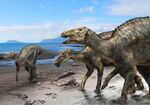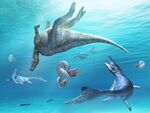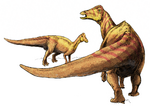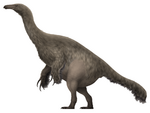Earth:Yezo Group
| Yezo Group Stratigraphic range: Aptian–Paleocene | |
|---|---|
| Type | Stratigraphic group |
| Sub-units | Shuparogawa Formation, Maruyama Formation, Hikagenosawa Formation, Saku Formation, Mikasa Formation, Kashima Formation, Haborogawa Formation, Osoushinai Formation, Hakobuchi Formation |
| Underlies | Ishikari Group, Poronai Group, Neogene deposits |
| Overlies | Sorachi Group |
| Thickness | 10,000 metres (32,810 ft) |
| Lithology | |
| Primary | Mudstone, sandstone |
| Other | Tuffite, conglomerate |
| Location | |
| Region | Hokkaido Sakhalin |
| Country | |
The Yezo Group is a stratigraphic group in Hokkaido, Japan and Sakhalin, Russia which is primarily Late Cretaceous in age (Aptian to Earliest Paleocene). It is exposed as roughly north–south trending belt extending 1,500 kilometres through central Hokkaido from Urakawa to Cape Sōya and Sakhalin from the south coast to Alexandrovsk-Sakhalinsky District.[1] It consists of marine forearc basin sediments, typically turbiditic and bioturbated mudstones and sandstones with subordinate conglomerate primarily deposited on the continental shelf and slope of the ancient Yezo subduction margin. It forms a continuous depositional sequence with the Sorachi Group, which overlies the Horokanai Ophiolite. The sequence gradually shallows upwards with the terminal Hakobuchi Formation representing a fluvial-inner shelf environment.[2]
Numerous fossils are known from the unit, mostly ammonites and bivalves, but also marine vertebrates such as mosasaurs, plesiosaurs [3] and marine turtles. Dinosaur remains are among the fossils that have been recovered from the group. These include a partial cervical vertebra and right hand from the therizinosaurid Paralitherizinosaurus, from Early Campanian Osoushinai Formation from northern Hokkaido.[4][5] Nipponosaurus is known from an unnamed unit of the group from Southern Sakhalin, probably late Santonian or early Campanian in age.[6] Kamuysaurus, which is known from the early Maastrichtian Hakobuchi Formation of southern Hokkaido, was also discovered in layers of this group.[7]
Fossil content
Reptiles
| Reptiles reported from the Yezo Group | |||||
|---|---|---|---|---|---|
| Genus | Species | Presence | Material | Notes | Images |
| Anomalochelys | A. angulata | Hobetsu-cho, Hokkaido. (Cenomanian)[8] | A nanhsiungchelyid. | ||
| Chupkaornis | C. keraorum | Kashima Formation (Coniacian to Santonian).[9] | A hesperornithiform. | ||
| Kamuysaurus | K. japonicus | Hakobuchi Formation.[7] | "A nearly complete skeleton with the skull and mandible (HMG-1219)".[7] | A hadrosaur. | |
| Mesodermochelys | M. undulatus | Hakobuchi Formation[10] and upper part of the Osoushinai Formation.[11] | -NMV-3, a proximal half of right humerus (Osoushinai Formation) .[11] | A dermochelyid turtle. | |
| M. sp. | Osoushinai Formation.[12] | A carapace with boreholes likely made by bivalves, and associated with many mollusc remains.[12] | A dermochelyid turtle. | ||
| Mosasaurus | M. hobetsuensis | Hakobuchi Formation.[13] | A mosasaurine mosasaur. | ||
| Nipponosaurus | N. sachalinensis | Sakhalin.[6][14] | A hadrosaur. | ||
| Paralitherizinosaurus | P. japonicus | Osoushinai Formation.[4] | Partial vertebra and partial right hand.[4] | A therizinosaur. | |
| Phosphorosaurus | P. ponpetelegans | Hakobuchi Formation.[13] | A well-preserved skull with some associated vertebrae. | A halisaurine mosasaur with proportionately large eyes and binocular vision. | |
| Pliosauridae gen. et. sp. indet. | Indeterminate | Cenomanian to Turonian localities in Hokkaido.[15] | 4 indeterminate remains.[15] | Pliosaur remains, some with skull sizes comparable to Megacephalosaurus. | |
| Taniwhasaurus | T. sp. | Kashima Formation.[16] | A fragmentary skull, not diagnostic to the species level. | A tylosaurine mosasaur also known from New Zealand, Antarctica, and South Africa; originally informally named 'Yezosaurus mikasaensis'. | |
Fish
| Fish reported from the Yezo Group | |||||
|---|---|---|---|---|---|
| Genus | Species | Presence | Material | Notes | Images |
| Apsopelix | A. miyazakii | Nakagawa Town[17] and Mikasa area,[18] Hokkaido (Turonian). | 2 specimens. | A crossognathid. | |
Echinoderms
| Echinoderms reported from the Yezo Group | |||||
|---|---|---|---|---|---|
| Genus | Species | Presence | Material | Notes | Images |
| ?Austinocrinus | ?A. sp. | Unknown locality, possibly in south-central Hokkaido, thought to be Santonian-Campanian.[19] | "One nodal and two pluricolumnals, associated on a bedding plane, so probably from a single individual".[19] | A crinoid. | |
| ?Balanocrinus | ?B. sp. | Upper Coniacian-Campanian portions of the Haborogawa Formation).[19] | One pluricolumnal.[19] | A crinoid. | |
| Isocrinus | I. sp. | Haborogawa Formation (upper Turonian-Coniacian).[19] | One pluricolumnal.[19] | A crinoid. | |
| Isselicrinus | I. sp. | Campanian upper Yezo Group.[19] | One pluricolumnal and five very poorly preserved columnals.[19] | ||
Molluscs
| Molluscs reported from the Yezo Group | |||||
|---|---|---|---|---|---|
| Genus | Species | Presence | Material | Notes | Images |
| ?Abyssochrysoidea | Osoushinai Formation.[12] | A single specimen found associated with the remains of a Mesodermochelys sp.[12] | A gastropod. | ||
| Bivalvia | Unidentified.[12] | Osoushinai Formation.[12] | A single specimen found associated with the remains of a Mesodermochelys sp.[12] | ||
| ?Cephalaspidea | Osoushinai Formation.[12] | A single specimen found associated with the remains of a Mesodermochelys sp.[12] | A gastropod. | ||
| Cheloniceras | C. sp. | Tsukenai Formation (Aptian).[20] | An ammonite. | ||
| Colombiceras | C. spathi | Tsukenai Formation (Aptian).[20] | An ammonite. | ||
| Gaudryceras | G. denseplicatum | Satonosawa Creek, Hokkaido (middle Turonian).[21] | An ammonoid. | ||
| ?Gyrodes | ?G. sp. | Osoushinai Formation.[12] | A single specimen found associated with the remains of a Mesodermochelys sp.[12] | ||
| Haboroteuthis | H. poseidon | Upper Haborogawa Formation (Upper Santonian).[22] | "KMNH IvP 902,002, a lower jaw."[22] | A teuthid. | |
| Hikidea | H. cf. yasukawensis | Osoushinai Formation.[12] | A single specimen found associated with the remains of a Mesodermochelys sp.[12] | ||
| Inoceramus | I. (Sphenoceramus) orientalis | Uppermost Haborogawa Formation (middle-upper part of the lower Campanian).[23] | A bivalve. | ||
| I. (Sphenoceramus) schmidti | Uppermost Haborogawa Formation (middle-upper part of the lower Campanian).[23] | A bivalve. | |||
| I. teshioensis | Gakkonosawa Creek, Hokkaido (late Turonian).[21] | Disarticulated valves.[21] | A bivalve. | ||
| Nanaimoteuthis | N. hikidai | Uppermost Haborogawa Formation (lower Campanian).[22] | "KMNH IvP 902,001, a lower jaw, the only specimen available."[22] | A vampyromorph. | |
| N. jeletzkyi | Hokkaido (Santonian to lower Campanian.)[24] | A vampyromorph. | |||
| N. yokotai | Satonosawa Creek and Gakkonosawa Creek, Hokkaido (middle and late Turonian).[21] | Jaw fossils. | A vampyromorph. | ||
| Paleocirroteuthis | P. sp. | Hokkaido (Santonian to lower Campanian).[24] | A cirroctopodid. | ||
| Provanna | P. cf. nakagawensis | Osoushinai Formation.[12] | 3 specimens found associated with the remains of a Mesodermochelys sp.[12] | An abyssochrysoid gastropod. | |
| Rhytidoplites | R. adkinsi | Tsukenai Formation (Aptian).[20] | An ammonite. | ||
| Scalarites | S. mihoensis | Gakkonosawa Creek, Hokkaido (late Turonian).[21] | An ammonoid. | ||
| S. scalaris | Satonosawa Creek, Hokkaido (middle Turonian).[21] | An ammonoid. | |||
| Tetragonites | T. glabrus | Satonosawa Creek, Hokkaido (middle Turonian).[21] | An ammonoid. | ||
| Thyasira | T. tanabei | Osoushinai Formation.[12] | 2 articulated specimens found associated with the remains of a Mesodermochelys sp.[12] | A bivalve. | |
Paleoflora
| Plants reported from the Yezo Group | |||||
|---|---|---|---|---|---|
| Genus | Species | Presence | Material | Notes | Images |
| Eydeia | E. hokkaidoensis | Haborogawa Formation (Coniacian-Santonian).[25] | 5 perimineralized fruits.[25] | A cornale similar to the extant Davidia involucrata. | |
| Mikasapteris | M. rothwellii | Mikasa Locality.[26] | A permineralized fertile pinnule.[26] | A probable stem polypodioid leptosporangiate fern. | |
| Mukawastrobus | M. satoi | Hakobuchi Formation.[27] | "A single cylindrical seed cone 2 cm long, 1.1 cm wide."[27] | A cypress. | |
| Nilssonia | N. yezoensis | Hakobuchi Formation.[28] | A cycad. | ||
| Obirafructus | O. kokubunii | Haborogawa Formation (Coniacian to Santonian).[29] | "A permineralized reproductive axis bearing at least 42 spirally arranged follicles."[29] | A saxifragale. | |
| Stockeystrobus | S. interdigitata | Hoborogawa Formation (Coniacian to Santonian).[30] | A seed cone.[30] | A sequoioid. | |
| Zamites | Z. bayeri | Kashima Formation (Coniacian).[31] | A bennettitale. | ||
See also
- List of dinosaur-bearing rock formations
References
- ↑ Shigeta, Yasunari; Maeda, Haruyoshi (2005). "Yezo Group Research in Sakhalin—A Historical Review". The Cretaceous System in the Makarov Area, Southern Sakhalin, Russian Far East (National Science Museum Monographs) 31: 1–24. https://www.kahaku.go.jp/english/research/researcher/papers/18151.pdf.
- ↑ Takashima, Reishi; Kawabe, Fumihisa; Nishi, Hiroshi; Moriya, Kazuyoshi; Wani, Ryoji; Ando, Hisao (June 2004). "Geology and stratigraphy of forearc basin sediments in Hokkaido, Japan: Cretaceous environmental events on the north-west Pacific margin". Cretaceous Research 25 (3): 365–390. doi:10.1016/j.cretres.2004.02.004.
- ↑ Kaim, Andrzej; Kobayashi, Yoshitsugu; Echizenya, Hiroki; Jenkins, Robert G.; Tanabe, Kazushige (2008). "Chemosynthesis-Based Associations on Cretaceous Plesiosaurid Carcasses". Acta Palaeontologica Polonica 53 (1): 97–104. doi:10.4202/app.2008.0106. ISSN 0567-7920. https://www.academia.edu/1427886.
- ↑ 4.0 4.1 4.2 Kobayashi, Yoshitsugu; Takasaki, Ryuji; Fiorillo, Anthony R.; Chinzorig, Tsogtbaatar; Hikida, Yoshinori (2022-05-03). "New therizinosaurid dinosaur from the marine Osoushinai Formation (Upper Cretaceous, Japan) provides insight for function and evolution of therizinosaur claws" (in en). Scientific Reports 12 (1): 7207. doi:10.1038/s41598-022-11063-5. ISSN 2045-2322. PMID 35504901. Bibcode: 2022NatSR..12.7207K.
- ↑ Murakami, Mizuki; Hirayama, Ren; Hikida, Yoshinori; Hirano, Hiromichi (December 2008). "A theropod dinosaur (Saurischia: Maniraptora) from the Upper Cretaceous Yezo Group of Hokkaido, Northern Japan". Paleontological Research 12 (4): 421–425. doi:10.2517/prpsj.12.421. ISSN 1342-8144.
- ↑ 6.0 6.1 Weishampel, David B; et al. (2004). "Dinosaur distribution (Late Cretaceous, Asia)." In: Weishampel, David B.; Dodson, Peter; and Osmólska, Halszka (eds.): The Dinosauria, 2nd, Berkeley: University of California Press. Pp. 593-600. ISBN:0-520-24209-2
- ↑ 7.0 7.1 7.2 Sakurai, Kazuhiko; Sato, Tamaki; Chinzorig, Tsogtbaatar; Tanaka, Kohei; Fiorillo, Anthony R.; Chiba, Kentaro; Takasaki, Ryuji; Nishimura, Tomohiro et al. (September 5, 2019). "A New Hadrosaurine (Dinosauria: Hadrosauridae) from the Marine Deposits of the Late Cretaceous Hakobuchi Formation, Yezo Group, Japan". Scientific Reports 9 (1): 12389. doi:10.1038/s41598-019-48607-1. PMID 31488887. Bibcode: 2019NatSR...912389K.
- ↑ Ren Hirayama; Kazuhiko Sakurai; Tsutomu Chitoku; Gentaro Kawakami; Norio Kito (2001). "Anomalochelys angulata, an unusual land turtle of family Nanhsiungchelyidae (Superfamily Treionychoidea; Order Testudines) from the Upper Cretaceous of Hokkaido, North Japan". Russian Journal of Herpetology 8 (2): 127–138. Archived from the original on 2011-08-26. https://web.archive.org/web/20110826064544/http://rjh.folium.ru/contents/2001/2001-02.htm.
- ↑ Tanaka, Tomonori; Kobayashi, Yoshitsugu; Kurihara, Ken'ichi; Fiorillo, Anthony R.; Kano, Manabu (2018-06-21). "The oldest Asian hesperornithiform from the Upper Cretaceous of Japan, and the phylogenetic reassessment of Hesperornithiformes". Journal of Systematic Palaeontology 16 (8): 689–709. doi:10.1080/14772019.2017.1341960. ISSN 1477-2019. https://doi.org/10.1080/14772019.2017.1341960.
- ↑ Hirayama, Ren; Chitoku, Tsutomu (1996). "1022 Family Dermochelyidae (Superfamily Chelonioidea) from the Upper Cretaceous of North Japan". 日本古生物学會報告・紀事 新編 1996 (184): 597–622. doi:10.14825/prpsj1951.1996.184_597. https://www.jstage.jst.go.jp/article/prpsj1951/1996/184/1996_184_597/_article/-char/ja/.
- ↑ 11.0 11.1 Hirayama, Ren; Hikida, Yoshinori (March 1998). "Mesodermochelys (Testudines; Chelonioidea; Dermochelyidae) from the Late Cretaceous of Nakagawa-cho, Hokkaido, North Japan". Bulletin of the Nakagawa Museum of Natural History 1: 69 to 76. https://www.researchgate.net/publication/256198184.
- ↑ 12.00 12.01 12.02 12.03 12.04 12.05 12.06 12.07 12.08 12.09 12.10 12.11 12.12 12.13 12.14 12.15 12.16 Jenkins, Robert; Kaim, Andrzej; Sato, Kei; Moriya, Kazuhiro; Hikida, Yoshinori; Hirayama, Ren (2017). "Discovery of chemosynthesis-based association on the Cretaceous basal leatherback sea turtle from Japan". Acta Palaeontologica Polonica 62. doi:10.4202/app.00405.2017. ISSN 0567-7920. https://www.researchgate.net/publication/319472309.
- ↑ 13.0 13.1 Konishi, Takuya; Caldwell, Michael W.; Nishimura, Tomohiro; Sakurai, Kazuhiko; Tanoue, Kyo (2016-10-02). "A new halisaurine mosasaur (Squamata: Halisaurinae) from Japan: the first record in the western Pacific realm and the first documented insights into binocular vision in mosasaurs". Journal of Systematic Palaeontology 14 (10): 809–839. doi:10.1080/14772019.2015.1113447. ISSN 1477-2019. https://doi.org/10.1080/14772019.2015.1113447.
- ↑ "HUSCAP journal". https://eprints.lib.hokudai.ac.jp/journals/item.php?item=34225&handle=2115_35768&jname=269&vname=3749.
- ↑ 15.0 15.1 Sato, Tamaki; Nagai, Katsuhisa; Echizenya, Hiroki; Shinmura, Tatsuya; Hikida, Yoshinori; Soeda, Yuji (2023-05-26). "Pliosaurid (Reptilia: Sauropterygia) remains from the Upper Cretaceous of Japan, and their biostratigraphic and paleogeographic significance" (in en). Cretaceous Research: 105593. doi:10.1016/j.cretres.2023.105593. ISSN 0195-6671. https://www.sciencedirect.com/science/article/pii/S0195667123001210.
- ↑ Matsui, Kumiko; Karasawa, Tomoki (2020-10-18). "3D models related to the publication: Interacting with the inaccessible: utilization of multimedia-based visual contents of Japan's National Monument, the Taniwhasaurus mikasaensis (Mosasauridae) holotype for educational workshops at Mikasa City Museum". MorphoMuseuM 6 (5): e106. doi:10.18563/journal.m3.106. ISSN 2274-0422. https://www.researchgate.net/publication/345340544.
- ↑ Yabumoto, Yoshitaka; Hikida, Yoshinori; Nishino, Takanobu (April 2012). "Apsopelix miyazakii, a New Species of Crossognathid Fish (Teleostei) from the Upper Cretaceous of Hokkaido, Japan". Paleontological Research 16 (1): 37–46. doi:10.2517/1342-8144-16.1.037. ISSN 1342-8144. https://bioone.org/journals/paleontological-research/volume-16/issue-1/1342-8144-16.1.037/Apsopelix-miyazakii-a-New-Species-of-Crossognathid-Fish-Teleostei-from/10.2517/1342-8144-16.1.037.full.
- ↑ Miyata, Shinya; Yabumoto, Yoshitaka; Nakajima, Yasuhisa; Ito, Yasuhiro; Sasaki, Takenori (April 2022). "A Second Specimen of the Crossognathiform Fish Apsopelix miyazakii from the Cretaceous Yezo Group of Mikasa Area, Central Hokkaido, Japan". Paleontological Research 26 (2): 213–223. doi:10.2517/PR200024. ISSN 1342-8144. https://bioone.org/journals/paleontological-research/volume-26/issue-2/PR200024/A-Second-Specimen-of-the-Crossognathiform-Fish-Apsopelix-miyazakii-from/10.2517/PR200024.full.
- ↑ 19.0 19.1 19.2 19.3 19.4 19.5 19.6 19.7 HUNTER, AARON W. (2012-12-12). "Crinoid diversity in the Upper Cretaceous Yezo Supergroup, Hokkaido, northern Japan". Zoosymposia 7 (1): 71–80. doi:10.11646/zoosymposia.7.1.7. ISSN 1178-9913. https://www.researchgate.net/publication/286342199.
- ↑ 20.0 20.1 20.2 Futakami, Masao (2018-09-01). "Aptian ammonite fauna from the Yezo Group of the Urakawa area in Hokkaido, Japan" (in en). Cretaceous Research 89: 224–234. doi:10.1016/j.cretres.2018.03.025. ISSN 0195-6671. https://www.sciencedirect.com/science/article/pii/S0195667117305141.
- ↑ 21.0 21.1 21.2 21.3 21.4 21.5 21.6 Tanabe, Kazushige; Hikida, Yoshinori (June 2010). "Jaws of a New Species ofNanaimoteuthis(Coleoidea: Vampyromorphida) from the Tuironian of Hokkaido, Japan". Paleontological Research 14 (2): 145–150. doi:10.2517/1342-8144-14.2.145. ISSN 1342-8144. https://www.researchgate.net/publication/232690105.
- ↑ 22.0 22.1 22.2 22.3 "Late Cretaceous record of large soft-bodied coleoids based on lower jaw remains from Hokkaido, Japan - Acta Palaeontologica Polonica" (in en). https://www.app.pan.pl/article/item/app000572013.html.
- ↑ 23.0 23.1 Tsujino, Yasuyuki (2009). "The Upper Cretaceous Hakobuchi Formation of the Yezo Group in the Kotanbetsu area, Hokkaido, northeast Japan". The Journal of the Geological Society of Japan 115 (3): 122–129. doi:10.5575/geosoc.115.122. https://www.jstage.jst.go.jp/article/geosoc/115/3/115_3_122/_article/-char/en.
- ↑ 24.0 24.1 Tanabe, Kazushige; Misaki, Akihiro; Hikida, Yoshinori; Nishimura, Tomohiro (February 2017). "New records of coleoid cephalopod jaws from the Upper Cretaceous of Hokkaido, Japan, and their paleobiogeographic and evolutionary implications". Cretaceous Research 70: 128–141. doi:10.1016/j.cretres.2016.10.009. ISSN 0195-6671. http://dx.doi.org/10.1016/j.cretres.2016.10.009.
- ↑ 25.0 25.1 Stockey, Ruth A.; Nishida, Harufumi; Atkinson, Brian A. (September 2016). "Anatomically preserved fossil cornalean fruits from the Upper Cretaceous of Hokkaido: Eydeia hokkaidoensis gen. et sp. nov." (in en). American Journal of Botany 103 (9): 1642–1656. doi:10.3732/ajb.1600151. ISSN 0002-9122. https://onlinelibrary.wiley.com/doi/10.3732/ajb.1600151.
- ↑ 26.0 26.1 Nishida, Harufumi; Stockey, Ruth A.; Takebe, Yusuke; Legrand, Julien; Yamada, Toshihiro (2022-07-25). "Mikasapteris rothwellii gen. et sp. nov., a Permineralized Fertile Pinnule of a Probable Stem Polypod from the Late Cretaceous of Hokkaido, Japan". International Journal of Plant Sciences 183 (7): 576–586. doi:10.1086/721262. ISSN 1058-5893. https://www.journals.uchicago.edu/doi/abs/10.1086/721262.
- ↑ 27.0 27.1 Stockey, Ruth A.; Nishida, Harufumi; Rothwell, Gar W. (2020). "Evolutionary diversification of taiwanioid conifers: evidence from a new Upper Cretaceous seed cone from Hokkaido, Japan". Journal of Plant Research 133 (5): 681–692. doi:10.1007/s10265-020-01214-y. PMID 32686035.
- ↑ Okubo, Atsushi. Nilssonia yezoensis, sp. nov., from the Upper Cretaceous Hakobuchi group, in Hokkaido, Japan. OCLC 249459457. http://worldcat.org/oclc/249459457.
- ↑ 29.0 29.1 Kajita, Yui; Suzuki, Mayumi Hanari; Nishida, Harufumi (May 2020). "A Multicarpellary Apocarpous Gynoecium from the Late Cretaceous (Coniacian–Santonian) of the Upper Yezo Group of Obira, Hokkaido, Japan: Obirafructus kokubunii gen. & sp. nov.". Acta Phytotaxonomica et Geobotanica 72 (1): 1–21. https://www.researchgate.net/publication/353759123.
- ↑ 30.0 30.1 Rothwell, Gar W.; Ohana, Tamiko (September 2016). "Stockeystrobusgen. nov. (Cupressaceae), and the evolutionary diversification of sequoioid conifer seed cones". Botany 94 (9): 847–861. doi:10.1139/cjb-2016-0025. ISSN 1916-2790. https://www.researchgate.net/publication/308181978.
- ↑ Yamada, Toshihiro (2009-10-01). "Structurally preserved Zamites bayeri Kvaček from the Coniacian Kashima Formation (Yezo Group) of Hokkaido, Japan" (in en). Cretaceous Research 30 (5): 1301–1306. doi:10.1016/j.cretres.2009.07.007. ISSN 0195-6671. https://www.sciencedirect.com/science/article/pii/S0195667109000810.
 |








